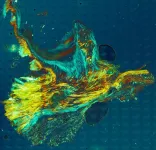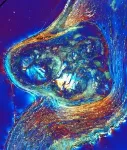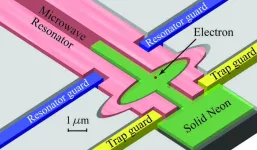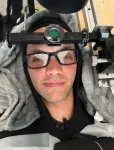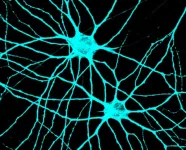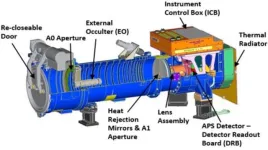(Press-News.org) CHAMPAIGN, Ill. — The human body has sophisticated defenses against the deposition of calcium minerals that stiffen heart tissues, researchers at the University of Illinois Urbana-Champaign and collaborators at UCLA Health and the University of Texas at Austin found in a new study that provides the first detailed, step-by-step documentation of how calcification progresses.
“Heart disease is the leading killer annually — about 18 million deaths per year — and that number is growing. A large proportion is the result of calcification,” said study leader Bruce Fouke, a U. of I. professor of earth science and environmental change and director of the Roy J. Carver Biotechnology Center at Illinois. “When the aortic valve calcifies, an ultra-invasive surgery to replace the valve is the only option currently. That heightens the urgency to get a handle on this process to more effectively move forward with drug development and testing.”
The aortic valve is the portal through which oxygenated blood gets pumped out of the heart to the body, opening and closing more than 3 billion times during the average lifespan. Calcium deposits can grow within the three tissue flaps that make up the valve, called leaflets, stiffening them and leaving them unable to open all the way.
“With calcification in blood vessels, a stent can help, but you can’t do that with the aortic valve. Every organ in the body can be in perfect condition, but if the aortic valve stops functioning, that's the end of that life,” said Mayandi Sivaguru, the first author of the paper and the director of the Cytometry and Microscopy to Omics Facility in the Carver Biotechnology Center.
Despite the prevalence and biological importance, little is known about how the calcium deposits form or grow. Fouke’s group has pioneered the field of “GeoBioMed,” a combination of geology, biology and medicine, and previously applied it to the study of kidney stones. In the new study, published in the journal Scientific Reports, Fouke’s group at Illinois teamed up with colleagues at the UCLA School of Medicine and the Jackson School of Geoscience at Texas to study and document the steps of calcium deposit formation in aortic valves from human cadaver hearts.
“We used more than 12 modalities of study, including optical microscopy, electron microscopy and spectroscopy, to investigate the nature and progression of mineralization and protein localization in the aortic valve for the first time. This multimodal analysis set us apart, uncovering a new line of evidence to better understand cardiovascular calcification,” Sivaguru said.
The starting point is healthy leaflet tissue. Then tiny spherules of calcium phosphate form in the smooth muscle layer of the leaflets.
Crucially, the team found that the form of calcium phosphate in the mineral deposits is not the same type as found in bone, called apatite, as has been widely thought. Instead, the deposits consist predominately of amorphous calcium phosphate, which has the ability to morphologically shapeshift and atomically rearrange.
As they grow, the spherules coalesce into layers that encrust and stiffen the collagen and smooth muscle fibers that give the leaflets their flexibility. These processes combine to form large nodules that rotate, touch each other and further stiffen the tissues.
“Immediately, we saw that the reactions within the tissues of the valves were virtually identical to those we’ve studied in coral reefs, hot springs and many other natural environments that harbor life-water-mineral interactions,” said Fouke, who is the Ralph E. Grim Professor at Illinois. “Our blood is saturated with calcium and phosphate. Calcification of collagen and growth of nodules is inevitable given our blood chemistry, biology and composition.
“However, the silver lining to all of this is that we also found that our body has evolved these incredibly intricate and effective processes to fight mineralization. It can’t stop it, but it can slow it down dramatically.”
The researchers found two defense mechanisms. As the tiny ACP spherules form and begin to coalesce, the heart tissues produce large amounts of the protein osteopontin. Osteopontin promotes apatite growth and calcification in bones and kidney stones, so the findings initially puzzled the researchers, Fouke said. But osteopontin has the opposite, inhibitory effect on ACP, slowing down collagen calcification and nodule aggregation.
“That’s why knowing it’s ACP instead of apatite is so important. Enhancing the release of osteopontin could be an important new target to slow down calcification to a level that it won't be a threat or require surgical intervention,” Fouke said.
The body’s second defense is the very collagen where the nodules form. The researchers found that as the nodules start growing, the collagen fibers stretch around and contain them, forming a water barrier that further slows nodule growth.
In addition to investigating possible therapeutic applications of osteopontin to slow calcification, the researchers also hope their work opens new avenues of investigation into preventing initial growth and dissolving already-formed mineral deposits throughout the human body.
In collaboration with Mayo Clinic, the team is now applying their multimodal GeoBioMed approach to studying calcification in human breast tumors, a hallmark of the disease.
The Barbara and Ed Weil Foundation, the National Institutes of Health (grant OT2OD023848) and the UCLA Amara-Yad project supported this work.
Editor’s note:
To reach Bruce Fouke, email fouke@illinois.edu. To reach Mayandi Sivaguru, email sivaguru@illinois.edu.
The paper, “Osteopontin stabilization and collagen containment slows amorphous calcium phosphate transformation during human aortic valve leaflet calcification,” is available online.
DOI: 10.1038/s41598-024-62962-8
END
A heart of stone: Study defines the process of and defenses against cardiac valve calcification
2024-06-26
ELSE PRESS RELEASES FROM THIS DATE:
Understanding quantum states: New FAMU-FSU research shows importance of precise topography in solid neon qubits
2024-06-26
Quantum computers have the potential to be revolutionary tools for their ability to perform calculations that would take classical computers many years to resolve.
But to make an effective quantum computer, you need a reliable quantum bit, or qubit, that can exist in a simultaneous 0 or 1 state for a sufficiently long period, known as its coherence time.
One promising approach is trapping a single electron on a solid neon surface, called an electron-on-solid-neon qubit. A study led by FAMU-FSU College of Engineering Professor Wei Guo that was ...
Review of pathogenesis, research and treatment of amyloidosis published in New England Journal of Medicine
2024-06-26
(Boston) — AL (immunoglobulin light chain) amyloidosis is a rare disease that often results in progressive organ dysfunction, organ failure and eventual death.
Clonal plasma cells in the bone marrow secrete free light chains into circulation. These light chains are part of immunoglobulins, also called antibodies. But in this disease, light chains misfold and aggregate into amyloid fibrils that deposit in organs and tissues.
In a review article of AL amyloidosis “Systemic Light Chain Amyloidosis,” Vaishali Sanchorawala, MD, director of the Amyloidosis Center at the Chobanian & ...
New research tools reveal the dynamics behind breaking a sweat
2024-06-26
Excessive heat across the United States is making this summer a season of sweat. Perspiration and its evaporation are crucial to keeping us cool when things get hot. But our understanding of how sweat evaporates is limited to the profuse phases of the process, when our bodies are coated in a sticky film or even pools of perspiration. Relatively is little is known about the dynamics behind initial phases of sweating, when tiny droplets are emitted by individual sweat glands and then quickly evaporate.
“There are mechanical engineering researchers around the world, myself included, who are devoted to understanding the different parameters of droplet behavior on ...
Neuroscience research leverages stem cells to understand how neurons connect and communicate in the brain
2024-06-26
Newly published research from Colorado State University answers fundamental questions about cellular connectivity in the brain that could be useful in the development of treatments for neurological diseases like autism, epilepsy or schizophrenia.
The work, highlighted in the Proceedings of the National Academy of Sciences, focuses on how neurons in the brain transmit information between each other through highly specialized subcellular structures called synapses. These delicate structures are key to controlling many processes across the nervous system via electrochemical ...
NRL CCOR launches on the GOES-U NOAA satellite to monitor space weather
2024-06-26
WASHINGTON – The U.S. Naval Research Laboratory’s (NRL) Compact Coronagraph (CCOR) was launched June 25, on the National Oceanic and Atmospheric Administration (NOAA) Geostationary Operational Environmental Satellite-U (GOES-U) from NASA – Kennedy Space Center to detect and characterize coronal mass ejections (CMEs).
The NOAA sponsored NRL to design, integrate, and test CCOR, a small space telescope that will create an artificial eclipse of the sun and ...
Study shows how liver damage from stress and aging might be reversible
2024-06-26
DURHAM, N.C. – While the liver is one of the body’s most resilient organs, it is still vulnerable to the ravages of stress and aging, leading to disease, severe scarring and failure. A Duke Health research team now might have found a way to turn back time and restore the liver.
In experiments using mice and liver tissue from humans, the researchers identified how the aging process prompts certain liver cells to die off. They were then able to reverse the process in the animals with an investigational drug.
The finding, which ...
Bone stem cells with IFITM5 mutation get caught in a loop leading to osteogenesis imperfecta type V
2024-06-26
A study conducted by researchers at Baylor College of Medicine and collaborating institutions reveals the molecular events leading to osteogenesis imperfecta type V, a form of brittle bone disease caused by a mutation in the gene IFITM5.
The mutation blocks the normal development of bone stem cells into mature cells, which would form healthy bones. Instead, the mutation leads to the formation of bones that are extremely brittle. Children with this disorder have recurrent fractures, bone deformities, chronic pain and other complications. ...
Tai Chi reduces risk of inflammatory disease, treats insomnia among breast cancer survivors
2024-06-26
New research led by UCLA Health confirms that both Tai Chi and cognitive behavioral therapy can reduce insomnia in breast cancer survivors but also may provide additional health benefits by reducing inflammation and bolstering anti-viral defenses.
Chronic insomnia is one of the most prominent symptoms experienced among cancer survivors and poses significant health concerns, including the risk of inflammatory disease that could increase the risk of cancer recurrence.
About 30% of breast cancer survivors are reported to have insomnia, which is twice the rate of the general population. While previous research has shown cognitive behavioral therapy and mind-body ...
Technology presented for measuring carbon in media, advertising and generative AI
2024-06-26
Measuring energy consumption derived from digital activity from a scientific point of view is the challenge faced by Hiili, S.L., a company recently formed and driven by two researchers from the Universidad Carlos III de Madrid (UC3M), Ángel and Rubén Cuevas Rumín, from the Telematics Engineering Department. Specifically, they develop technological solutions that combine Internet measurement techniques and Artificial Intelligence (AI) to make an accurate estimate of the energy consumption of a company's ...
Do people who exercise more have a lower risk of ALS?
2024-06-26
EMBARGOED FOR RELEASE UNTIL 4 P.M. ET, WEDNESDAY, JUNE 26, 2024
MINNEAPOLIS – Moderate levels of physical activity and fitness may be linked to a reduced risk of amyotrophic lateral sclerosis (ALS) later in life, according to a new study published in the June 26, 2024, online issue of Neurology®, the medical journal of the American Academy of Neurology. The study only found an association between physical activity and risk of ALS in male participants, not female participants.
ALS is a rare, progressive neurodegenerative disease that affects nerve cells in the brain and the spinal cord. People with ALS lose the ability to initiate ...
